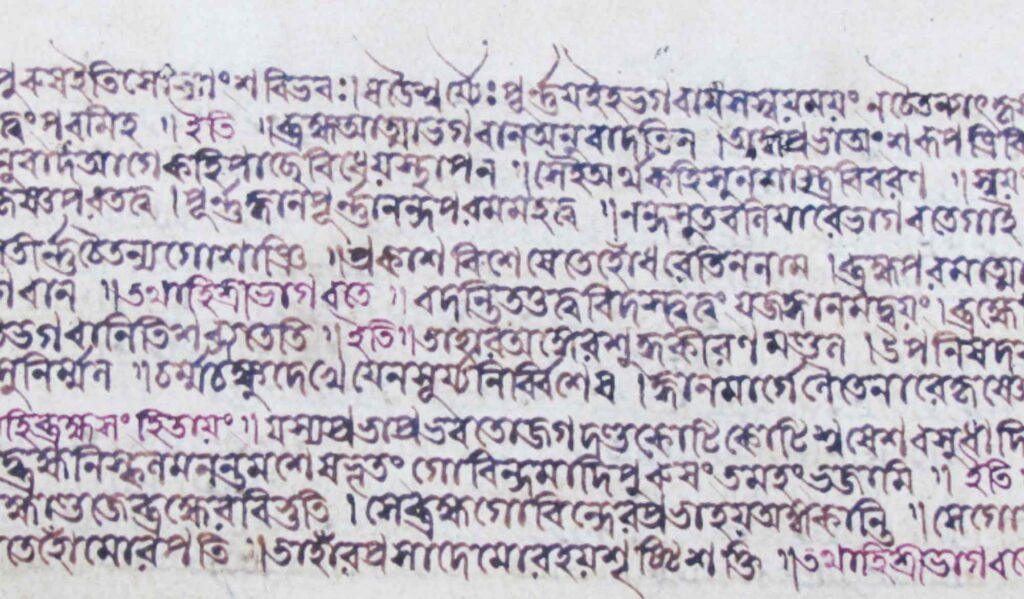Vaiṣṇava Siddhānta Mālā Part 1 – Chapter Five
Bheda-satya
(Differences are Real)
Question: Both Bhagavān and the jīvas are described as caitanya (conscious), so is the difference between them imaginary?
Answer: No. Bhagavān is vibhu-caitanya (infinite consciousness) and the jīva is anu–caitanya (finite consciousness), thus the difference between them is not imaginary, but real. Bhagavān is the Controller of His māyā-śakti, and the jīva is subordinate to māyā.
Question: How many kinds of bheda (differences) are there?
Answer: There are two types – vyavahārika (conventional) and tāttvika (essential).
Question: What kind of difference is vyavahārika?
Answer: There is a conventional difference between a clay pot and a piece of cloth, but because the cause of both of them is earth, there is no difference between the two, so this difference is called vyavahārika-bheda.
Question: What kind of difference is tāttvika?
Answer: When two objects are different in both their function and their cause, then this type of difference is called tāttvika.
Question: Is the difference between the jīva and Bhagavān vyavahārika or tāttvika?
Answer: Tāttvika.
Question: Why?
Answer: There is no condition when the jīva can become Bhagavān.
Question: Then what is the meaning of mahā-vākyas such as tat-tvam-asi etc?*
* The mahā-vākyas are four statements that the Advaitins have culled from the Upaniṣads that apparently support their doctrine of non-dualism. One of these mahā–vākyas is tat-tvam-asi (‘you are that’), a statement from Chandogya Upaniṣad (6.14).
Answer: Śvetaketu was instructed, “You are a jīva, you are not manifest from matter, but you have manifest from caitanya (consciousness).* It should not be understood from this instruction that you are vibhu-caitanya.”
* This is the meaning of tat tvam asi, as taught to Śvetaketu by his guru.
Question: Then are statements stressing non-difference (abheda-vākya) of the jīva and Brahman incorrect?
Answer: From the jīva’s perspective, the difference between the two is eternal; from the Lord’s perspective, the non-difference is eternal. Therefore, the difference and non-difference are simultaneously eternal and true.
Question: How can we understand this viruddha–siddhānta (contradictory conclusion)?
Answer: Through Bhagavān’s acintya-śakti, all contradictory tattvas can be harmonised. For those jīvas with meagre intellect, such things are impossible.
Question: Then why do we hear criticism of abhedavāda (the philosophy of non-difference)?
Answer: The followers of abhedavāda only accept non-difference as eternal, and say that difference is temporary. Śrī Madhvācārya has established difference as eternal, and thus the philosophy of acintya–bhedābheda (simultaneous oneness and difference) has been confirmed. There are no faults in those who accept the philosophy of bhedābheda. But both kevala–bhedavādīs (exclusive dualists) and those who are kevala–abhedavādīs (exclusive monists) are contaminated by the fault of their one-sided bias.
Question: Whose philosophy is kevala-abhedavāda?
Answer: The nirviśeṣavādīs (followers of impersonalism), accept the philosophy of abhedavāda. The saviśeṣavādīs (followers of personalism) do not accept abhedavāda.
Question: Who accepts the philosophy of saviśeṣavāda?
Answer: Saviśeṣavāda is the philosophy accepted by all Vaiṣṇava sampradāyas.
Question: How many sampradāyas do the Vaiṣṇavas have?
Answer: There are four Vaiṣṇava sampradāyas: Dvaita (exclusive dualism), Viṣiṣṭādvaita (qualified monism), Dvaitādvaita (oneness and difference) and Śuddhādvaita (pure monism).
Question: What are the differences amongst these philosophies?
Answer: There are no differences amongst these philosophies. They are all saviśeṣavādīs. None of them accept kevalābhedavāda. They are all devoted to Bhagavān, and they accept the Lord’s will. The Dvaitavādīs say that kevalādvaitavāda is a philosophy of darkness. They have shown the eternality of Dvāitavāda. This is the philosophy of Śrī Madhvācārya. The viśiṣtādvaitī says that all objects have distinctions, therefore they do not accept kevalādvaitavāda. The Dvaitādvaita philosophy very clearly condemns kevalādvaitavāda. Śuddhādvaita philosophy also condemns kevalādvaitavāda and describes pure distinctions. If properly understood, one will not see any difference between these four.
Question: Then why did Śrī Śrī Mahāprabhu only accept the philosophy of Madhva?
Answer: The specific quality of Madhvā’s philosophy is this – of all philosophies, his clearly refutes the misconceptions of kevalādvaitavāda. If we take this stance, the suffering that comes from abhedavāda is driven far away. Indeed, in order to bring auspiciousness to those who are weak, Śrī Śrī Mahāprabhu accepted this philosophy. Despite this, we should not think the other three philosophies are inferior in any way. In any form, the doctrine of saviśeṣavāda certainly provides eternal auspiciousness for the jīvas.









